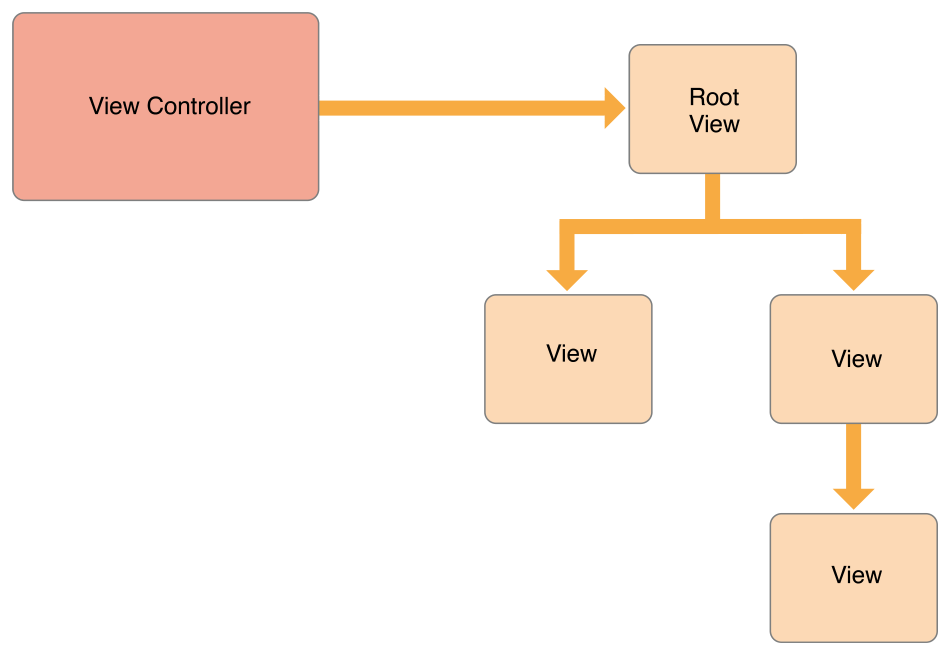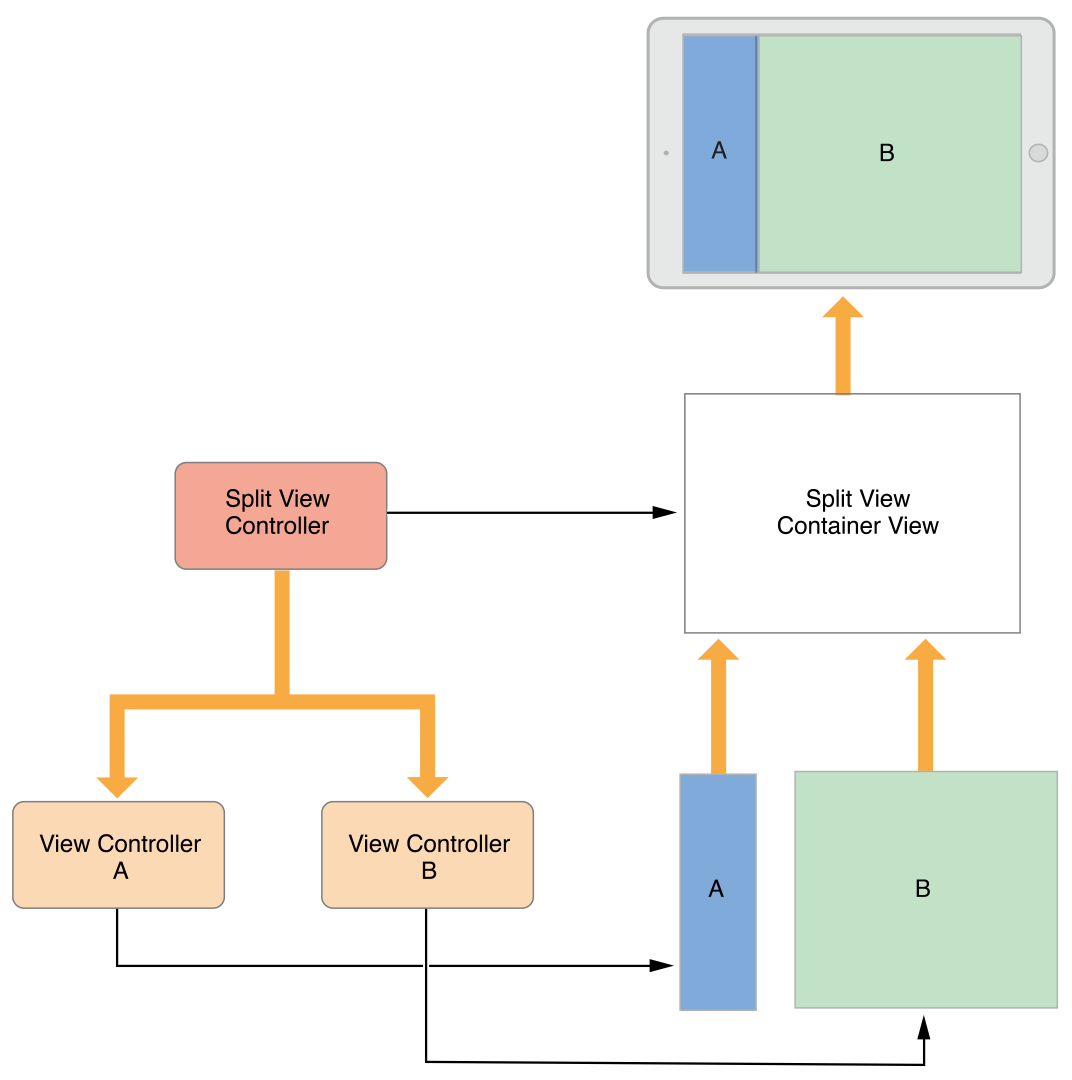The Role of View Controllers
https://developer.apple.com/library/content/featuredarticles/ViewControllerPGforiPhoneOS/index.html#//apple_ref/doc/uid/TP40007457-CH2-SW1
View controllers are the foundation of your app’s internal structure. Every app has at least one view controller, and most apps have several. Each view controller manages a portion of your app’s user interface as well as the interactions between that interface and the underlying data. View controllers also facilitate transitions between different parts of your user interface.
Because they play such an important role in your app, view controllers are at the center of almost everything you do. The UIViewController class defines the methods and properties for managing your views, handling events, transitioning from one view controller to another, and coordinating with other parts of your app. You subclass UIViewController (or one of its subclasses) and add the custom code you need to implement your app’s behavior.
There are two types of view controllers:
Content view controllers manage a discrete piece of your app’s content and are the main type of view controller that you create.
Container view controllers collect information from other view controllers (known as child view controllers) and present it in a way that facilitates navigation or presents the content of those view controllers differently.
Most apps are a mixture of both types of view controllers.
View Management
The most important role of a view controller is to manage a hierarchy of views. Every view controller has a single root view that encloses all of the view controller’s content. To that root view, you add the views you need to display your content. Figure 1-1 illustrates the built-in relationship between the view controller and its views. The view controller always has a reference to its root view and each view has strong references to its subviews.
Figure 1-1Relationship between a view controller and its views
NOTE
It is common practice to use outlets to access other views in your view controller’s view hierarchy. Because a view controller manages the content of all its views, outlets let you store references to the views that you need. The outlets themselves are connected to the actual view objects automatically when the views are loaded from the storyboard.
A content view controller manages all of its views by itself. A container view controller manages its own views plus the root views from one or more of its child view controllers. The container does not manage the content of its children. It manages only the root view, sizing and placing it according to the container’s design. Figure 1-2 illustrates the relationship between a split view controller and its children. The split view controller manages the overall size and position of its child views, but the child view controllers manage the actual contents of those views.
Figure 1-2View controllers can manage content from other view controllers
For information about managing your view controller’s views, see Managing View Layout.
The Role of View Controllers的更多相关文章
- 【IOS笔记】Creating Custom Content View Controllers
Creating Custom Content View Controllers 自定义内容视图控制器 Custom content view controllers are the heart of ...
- View Controller Programming Guide for iOS---(四)---Creating Custom Content View Controllers
Creating Custom Content View Controllers 创建自定义内容视图控制器 Custom content view controllers are the heart ...
- View Controller Programming Guide for iOS---(一)---About View Controllers
About View Controllers View controllers are a vital link between an app’s data and its visual appear ...
- Presenting view controllers on detached view controllers is discouraged <CallViewController: 0x14676e240>.
今天在优化app时,发现程序出现这种警告:“ Presenting view controllers on detached view controllers is discouraged <C ...
- 更轻量的 View Controllers
iew controllers 通常是 iOS 项目中最大的文件,并且它们包含了许多不必要的代码.所以 View controllers 中的代码几乎总是复用率最低的.我们将会看到给 view con ...
- 【IOS笔记】Resource Management in View Controllers
Resource Management in View Controllers 视图控制器的资源管理 View controllers are an essential part of managin ...
- 【IOS笔记】Using View Controllers in Your App
参考:http://www.cnblogs.com/patientAndPersist/p/3279645.html Using View Controllers in Your App Whethe ...
- iphone dev 入门实例2:Pass Data Between View Controllers using segue
Assigning View Controller Class In the first tutorial, we simply create a view controller that serve ...
- iOS错误之-Presenting view controllers on detached view controllers is discouraged
遇到这个警告后找了一下网络资源,基本上只说通过 [self.view.window.rootViewController presentViewController:controller animat ...
随机推荐
- excel查找定位操作(for lutai)
产成品出库的单价要根据订单号和存货编码引用产成品入库的单价 方法一:使用Index 和Match =INDEX(产成品入库!I2:P13 ,IF( ) ,7) 方法二:使用vlookup ,首先 ...
- 《PHP7底层设计与源码实现》学习笔记2——结构体对齐
书里给了一段代码,假如有个结构体如下: struct test { char a; int b; long c; void* d; int e; cha ...
- JavaScript入门(二)
JavaScript入门—操作DOM树 要点 DOM树是一个树形结构,操作DOM树通常是“更新.遍历.新增.删除”. 更新DOM树 拿到DOM节点 var id=document.getElement ...
- 测试欧气的小游戏-java
Java 用我们学到的知识做处一个小的项目或者游戏等等应该都或多或少的有一点点的成就感吧,下列就是我用所学的基础知识做的猜字谜游戏,并且给他赋予了灵魂哈哈哈.有兴趣的可以尝试的用自己会的知识做一些小的 ...
- Java自学-接口与继承 接口
设计Java的接口 在设计LOL的时候,进攻类英雄有两种,一种是进行物理系攻击,一种是进行魔法系攻击 这时候,就可以使用接口来实现这个效果. 接口就像是一种约定,我们约定某些英雄是物理系英雄,那么他们 ...
- 时间格式在ios和安卓兼容性的问题:
在做项目时,在时间显示上遇到一个问题,取后台返回的时间时,在ios手机上时间不显示,安卓手机正常,最后通过Vconsole工具发现,ios不能支持用“—”分割的时间,此外后台返回的时间格式为x年x月x ...
- [摘录]flutter打包后无法访问接口
打开文件{{flutterPorject}}\android\app\src\main\AndroidManifest.xml这个文件增加权限信息: <uses-permission andro ...
- web和网络基础
TCP/IP 协议族按层次分别分为以下 4 层: 应用层. 传输层. 网络层和数据链路层 把 TCP/IP 层次化是有好处的. 比如, 如果互联网只由一个协议统筹, 某个地方需要改变设计时, 就必须把 ...
- docker下安装redis集群
docker-compose.yml master: image: redis:4 container_name: redis-cluster_master command: redis-server ...
- window10体验terminal
体验window-terminal(preview),很不错可以直接登录服务器通过ssh 01.打开store 02.搜索terminal 03.体验ssh主机 04.很爽,可以ctrl + 鼠标滚轮 ...
